This article discussed measuring SEO progress by documenting changes, leveraging analytics platforms, and showing progress toward goals. By doing this, you can track the website’s SEO efforts progress and demonstrate the value of investing in SEO.
Introduction
Documenting Changes
Technical SEO Improvements
Leveraging Analytics Platforms
Showing Progress Toward Goals
Measuring SEO Progress: Leveraging Technical SEO, Analytics Platforms, and Showing Progress Toward Goals
Search Engine Optimization (SEO) is essential to any website’s success. It can be challenging to measure SEO progress, however, as the results of changes are often not immediately visible. That’s why it is important to document changes, leverage analytics platforms, and measure progress toward goals.
Introduction
Search engine optimization (SEO) is essential to any website’s success. It can be challenging to measure SEO progress, however, as the results of changes are often not immediately visible. That’s why it is important to document changes, leverage analytics platforms, and measure progress toward goals. This article will discuss measuring SEO progress and demonstrate the value of investing in SEO.
Documenting Changes
The first step in measuring SEO progress is to document all changes that are made to the website. This includes changes to the website’s content, structure, or design. By documenting these changes, you can track the progress of the site’s SEO efforts and measure the impact of the changes.
Technical SEO Improvements
Technical SEO improvements are often the quickest way to improve search visibility and keyword rankings. Technical SEO involves optimizing the website’s structure and code to make it more search-engine friendly. This includes optimizing the website’s XML sitemaps and ensuring they are submitted to Google Search Console. It also involves optimizing the website’s redirects, page speed, and other technical elements.
Leveraging Analytics Platforms
Analytics platforms can be used to measure SEO progress. These platforms provide detailed information about the website’s performance, including the number of visitors, the sources of the visitors, and the keywords that drive traffic to the website. This information can be used to identify areas of improvement and track the progress of SEO efforts.
Showing Progress Toward Goals
The final step in measuring SEO progress is to show progress toward goals. This can be done by tracking the website’s performance over time and comparing it to the goals set. This will allow you to identify areas where progress is being made and areas that need to be improved.
Conclusion: Measuring SEO progress can be difficult, but it is essential for demonstrating the value of investing in SEO. By documenting changes, leveraging analytics platforms, and showing progress toward goals, you can measure SEO progress and demonstrate the value of SEO.
Measuring SEO progress is critical to understanding the impact of changes and tracking results.
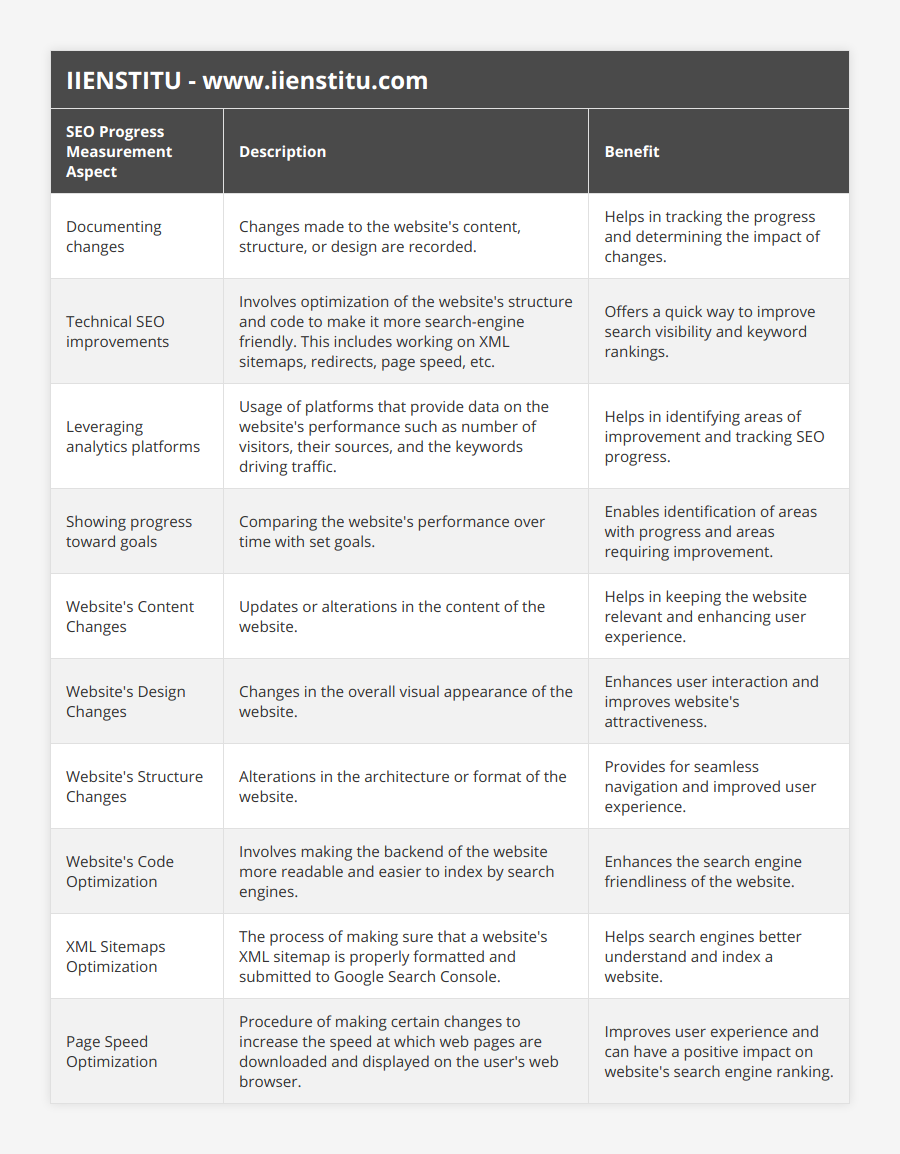
Frequently Asked Questions
What methods can be used to document changes in SEO progress?
When tracking SEO progress, it is essential to have an effective documentation system. The proper documentation method can help track SEO changes and provide insight into the success of a website’s search engine optimization efforts. In this article, we will discuss the various methods of documentation that can be used to document changes in SEO progress.
The first method of documentation that can be used to track SEO progress is through the use of analytics tools. Analytics tools such as Google Analytics, Adobe Analytics, and Webmaster Tools can provide valuable insights into how a website performs in terms of SEO. For example, these tools can track the number of organic visitors to a website, the number of pages indexed, and other metrics related to SEO. This data can then be used to monitor SEO performance over time.
The second method of documentation that can be used to track SEO progress is using rank tracking tools. Rank tracking tools such as SE Ranking, SERP Mojo, and SE Monitor can be used to track a website’s ranking in the search engine results pages (SERPs) for various keywords. This data can then be used to track changes in SEO performance over time.
The third method of documentation that can be used to track SEO progress is using keyword research tools. Keyword research tools such as Google Keyword Planner and Moz Keyword Explorer can be used to track the performance of various keywords in the SERPs. This data can then be used to compare the performance of different keywords and understand how SEO affects a website.
Finally, the fourth method of documentation that can be used to track SEO progress is competitor analysis tools. Competitor analysis tools such as SEMrush and Ahrefs can be used to track the SEO performance of competing websites. This data can then be used to understand how a website performs in comparison to its competitors and make changes to its SEO strategy as necessary.
In conclusion, there are a variety of methods of documentation that can be used to track changes in SEO progress. Analytics, rank tracking, keyword research, and competitor analysis tools can provide valuable insights into a website’s performance in the SERPs. By utilizing these documentation methods, it is possible to understand better how SEO affects a website and make changes to its SEO strategy as necessary.
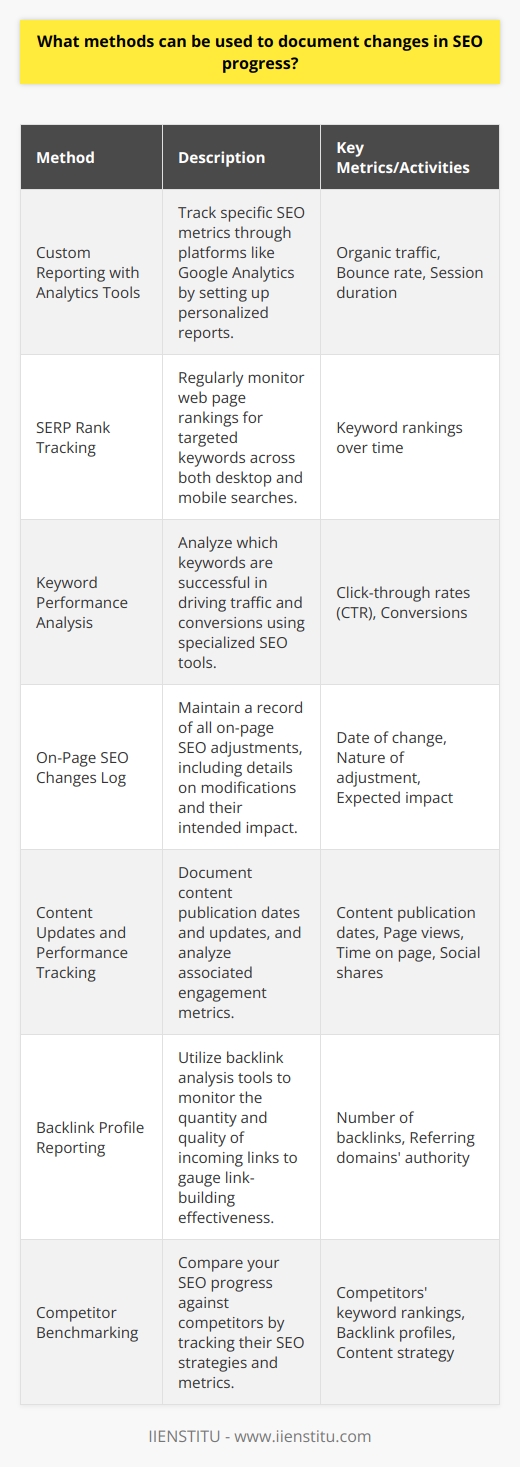
How can analytics platforms be leveraged to track SEO results?
SEO, which stands for Search Engine Optimization, is critical for success in digital marketing. It helps businesses increase their visibility and reach potential customers through organic search engine results. As a result, tracking SEO results is essential for companies to understand how their efforts impact their online presence. Analytics platforms can be leveraged to track SEO results effectively.
Analytics platforms offer a range of capabilities that can be used to measure and analyze SEO performance. For example, the platform can provide insights into the number of visitors to a website, the average time spent on the website, and the sources of traffic. This data can be further analyzed to understand how SEO strategies impact website performance. Additionally, analytics platforms can track keyword performance and provide insights into which keywords are helping to drive website traffic and conversions.
Analytics platforms can also be used to measure the success of content marketing efforts. For example, the platform can track the number of views, shares, and comments on content pieces and the number of backlinks generated. This data can be used to identify which content pieces are performing well and which need to be improved. Additionally, the platform can provide insights into organic search engine performance, including organic traffic, rankings, and visibility.
Analytics platforms can also be used to track the performance of off-site SEO efforts. For example, the platform can measure the success of link-building campaigns and provide insights into the quality of backlinks. Additionally, the platform can track the performance of social media marketing campaigns and provide insights into the reach and engagement of posts.
Finally, analytics platforms can be leveraged to measure the success of SEO campaigns. For example, the platform can track the number of leads, conversions, and revenue generated from organic search engine traffic. This data can be used to optimize campaigns and ensure that businesses are getting the most out of their SEO efforts.
Analytics platforms can be a powerful tool for tracking SEO results. They provide insights into website performance, content marketing, off-site SEO efforts, and overall SEO campaigns. Businesses can leverage these platforms to ensure that their SEO efforts deliver the desired results.
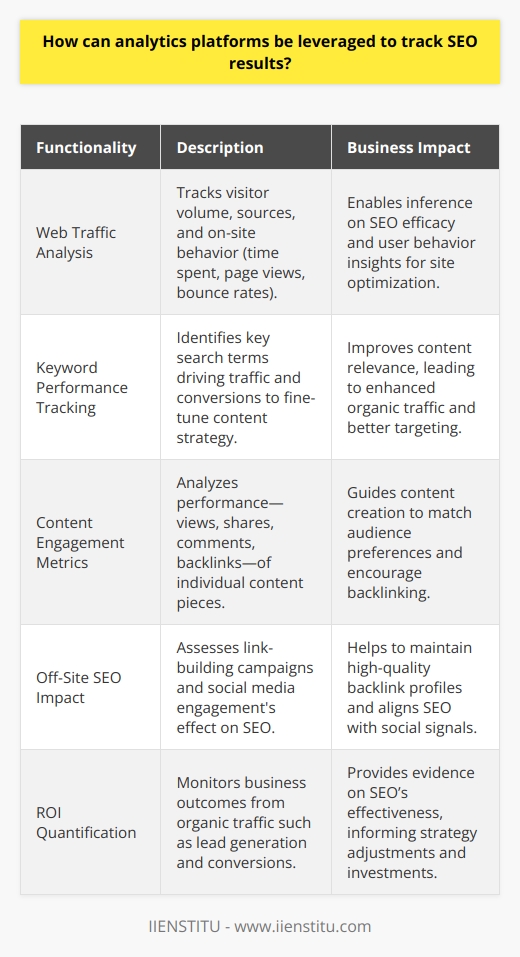
What are some effective ways to show progress toward SEO goals?
Search engine optimization (SEO) is a crucial tool for improving a website’s visibility and can be instrumental in increasing web traffic and promoting website optimization. Therefore, it is essential for website owners to have a clear understanding of their SEO goals and to be able to track progress toward those goals. In this article, we will discuss some practical ways to show progress toward SEO goals.
One meaningful way to show progress toward SEO goals is to track keyword rankings. Many website owners use keyword tracking tools to monitor the position of their website about their chosen keywords. This enables them to understand how their website’s visibility is increasing about their chosen keywords and can help them to identify areas in which they need to improve their SEO strategy.
Another effective way to show progress toward SEO goals is to monitor website traffic. Many website owners use analytics tools to track the number of visitors to their website and determine which traffic sources are most effective. This enables them to understand which SEO techniques yield the best results and identify areas where they can improve.
A third way to show progress toward SEO goals is to track changes in the website content. Website owners can use a content management system to track changes in the range of their websites. This enables them to understand which content changes are having the most impact on their SEO performance and to identify areas where they can make improvements.
Finally, website owners can use link-building strategies to show progress toward SEO goals. Link-building involves creating links from other websites to your own. This helps to boost your website’s visibility, as search engines view links as a sign of trust. Additionally, link-building can help to increase web traffic as users may click on the links to visit your website.
In conclusion, several effective ways to show progress toward SEO goals exist. These include tracking keyword rankings, monitoring website traffic, tracking changes in website content, and using link-building strategies. By monitoring these metrics, website owners can understand how their SEO efforts are paying off and can make improvements where necessary.

How do you track and measure SEO results in the context of organic traffic and user engagement?
Subheadings:
Importance of Monitoring SEO Results
Using Analytics Tools to Measure Organic Traffic
Empirical Indicators of User Engagement
Importance of Monitoring SEO Results
To demonstrate the effectiveness of search engine optimization (SEO) strategies, it is essential to track and measure key performance indicators (KPIs). Monitoring these KPIs ensures that a blog post reaches its intended audience and converts them into loyal visitors.
Using Analytics Tools to Measure Organic Traffic
One critical aspect of SEO success is monitoring organic traffic, primarily through popular analytics tools such as Google Analytics. These tools break down incoming traffic by source, allowing bloggers to observe spikes in organic visits generated by search engines. This information helps gauge the efficacy of keyword targeting, identify areas to improve, and ultimately refine SEO efforts. Moreover, analyzing organic search data enables the identification of patterns of user behavior, such as the keywords they used to find the blog post, and the pages they visited subsequently.
Empirical Indicators of User Engagement
Furthermore, user engagement metrics also provide valuable insights into the blog post's performance. Some crucial engagement indicators include bounce rate, average time on page, and conversion rate. A lower bounce rate signposts that the visitor found the content relevant and further explored the website, whereas a higher rate may suggest the need for content optimization. Additionally, the average time spent on the page is an indicator of the visitors' interest level in the blog post, as longer periods denote content resonance. Lastly, conversion rates reflect the ability of the blog post to persuade visitors to take desired actions, such as subscribing to a newsletter or making a purchase.
In summary, regular tracking of SEO results, using analytics tools to measure organic traffic, and monitoring user engagement metrics are crucial for understanding and optimizing a blog post's overall success. This data-driven approach enables continuous improvement of SEO strategies, maximizing the post's visibility and impact on the target audience.
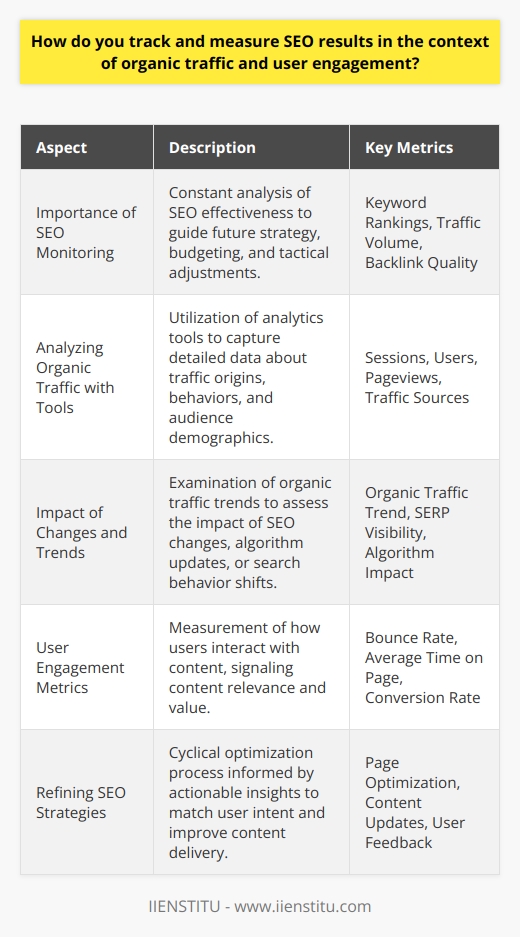
What metrics do you use to measure SEO success in terms of keyword ranking and online visibility?
Keyword Ranking Metrics
To measure SEO success in terms of keyword ranking, several metrics can provide valuable insights. First and foremost, keyword positions reflect the website's ranking on search engine results pages (SERPs) for specific keywords; higher positions indicate better optimization efforts. Monitoring fluctuations in keyword rankings, through tools like Google Search Console, allows for identifying areas of improvement and making adjustments to enhance search visibility.
Organic Traffic Analysis
Another critical metric is organic search traffic, which refers to the number of users visiting a website via search engines without paid promotion. Evaluating organic traffic growth rates can also indicate the effectiveness of SEO strategies, such as keyword targeting and optimization. Implementing tools like Google Analytics can reveal which keywords attract the most visitors and enable data-driven decisions regarding content development and optimization.
Click-Through Rate (CTR)
CTR represents the percentage of users who click on a website's link compared to the total number of impressions. High CTRs suggest that the title and meta description are compelling and entice users to visit the site. Analyzing CTRs and making improvements to the titles and descriptions can further optimize keyword ranking and online visibility.
Bounce Rate and Dwell Time
User engagement metrics, such as bounce rate and dwell time, are essential for measuring SEO success. Bounce rate measures the percentage of visitors who leave the website after viewing only the landing page, with lower bounce rates reflecting higher engagement levels. On the other hand, dwell time is the amount of time users spend on the website before returning to SERPs. Long dwell times indicate that website content is relevant, engaging, and valuable to users, positively impacting keyword ranking and online visibility.
Domain Authority (DA) and Page Authority (PA)
DA and PA are ranking factors developed by Moz to predict a website's ability to rank on SERPs. Higher DA and PA scores suggest that the site has gained credibility and authority through inbound links, content quality, and ethical SEO practices. Improving these scores can significantly enhance keyword ranking and overall online visibility, highlighting the importance of monitoring these metrics.
In conclusion, measuring SEO success involves analyzing a variety of metrics, including keyword positions, organic traffic, CTR, user engagement, and domain/page authority. Regularly assessing these metrics helps identify areas for improvement and optimization, ultimately leading to higher keyword rankings and increased online visibility.
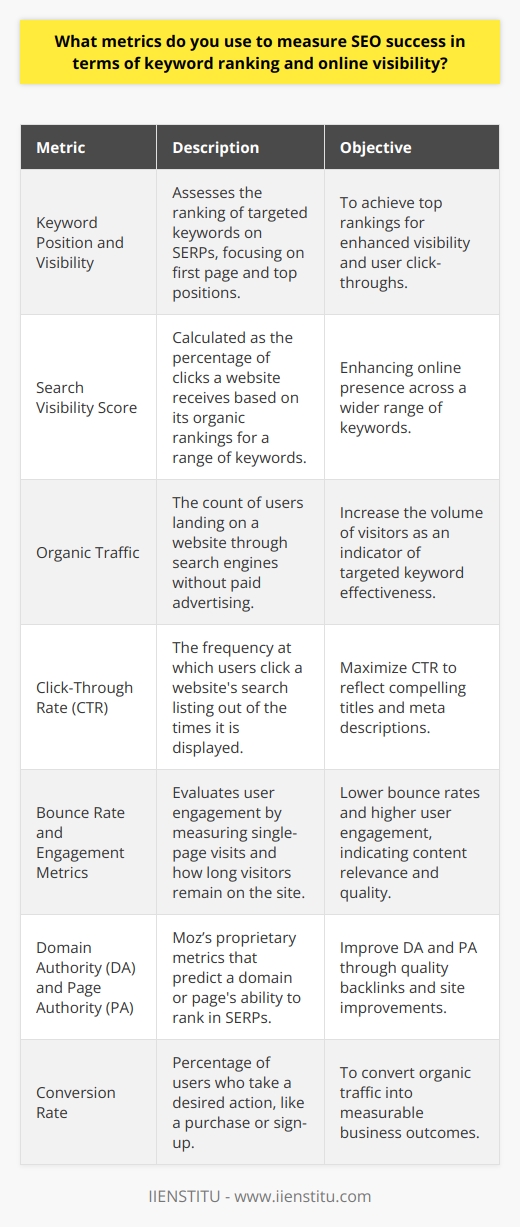
How can the impact of on-page and off-page optimization strategies be assessed for overall SEO performance?
On-page and Off-page Optimization Analysis
When analyzing the effectiveness of on-page and off-page optimization strategies for a blog post's overall Search Engine Optimization (SEO) performance, several assessment methods can be employed.
Metrics for On-page Optimization
Considering various metrics aids in understanding the influence of on-page optimization techniques on a blog post's SEO performance.
Keyword Targeting: Examine the distribution of targeted keywords throughout the blog post, such as in the title, headings, and main content. Effective keyword targeting generates higher search rankings and attracts organic traffic.
Content Quality: Evaluating the content's value, relevance to the target audience, and readability leads to a better understanding of its on-page optimization. High-quality content improves user engagement and increases the likelihood of backlinks.
Page Load Time: Assessing a blog post's load speed allows for the identification and reduction of factors causing slow page loading. A fast-loading blog post offers better user experience and contributes to higher SEO rankings.
HTML Markup Enhancements: Analyzing the usage of meta tags, header tags, and structured data markup provides insight into the effectiveness of on-page optimization. These components facilitate better search engine understanding and display of blog posts.
Metrics for Off-page Optimization
Evaluating the impact of off-page optimization efforts can be achieved by monitoring the following external factors:
Backlinks Profile: Backlinks signify a crucial aspect of off-page SEO. Examining the number, quality, and relevance of backlinks pointing to the blog post reveals valuable insights into its off-page optimization efforts.
Social Signals: Measuring the social media presence of a blog post, including shares, likes, and comments, sheds light on the effectiveness of the off-page optimization approach. A strong social media presence amplifies the visibility and reach of the blog post.
Domain Authority: Assessing a website's overall domain authority establishes credibility and increases trust in search engines. A high domain authority positively impacts the blog post's off-page SEO performance.
Brand Mentions: Monitoring the number of brand mentions and discussions about the blog post on various online platforms can indicate the success of an off-page optimization strategy. Such engagements lead to increased brand visibility and improved SEO performance.
Conclusion
Monitoring these metrics continuously helps assess the combined impact of on-page and off-page optimization strategies on a blog post's overall SEO performance. Gaining insights into these factors enables addressing areas of improvement, ultimately leading to more significant search engine visibility and organic traffic.
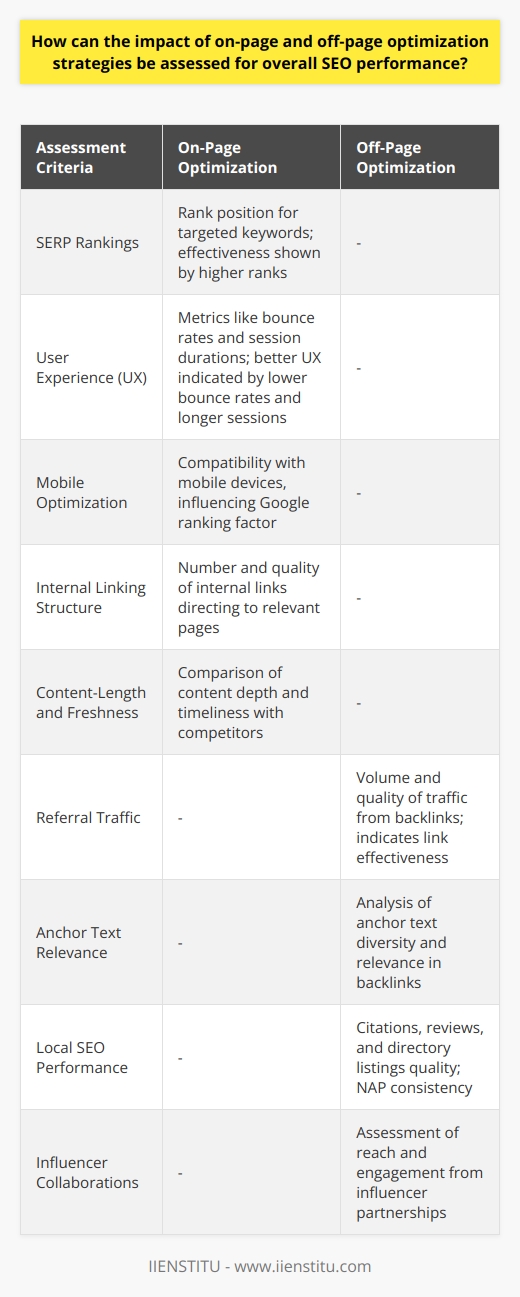
How do you track and measure SEO results in relation to website conversion rates and user behavior?
Tracking SEO Results
To effectively gauge the impact of search engine optimization (SEO) strategies on website conversion rates and user behavior, several analytics tools and key performance indicators (KPIs) are employed. Primarily, webmasters rely on Google Analytics to ascertain specific metrics that shed light on the efficiency of their SEO efforts.
Measuring Organic Traffic
A crucial aspect of tracking SEO results involves monitoring organic traffic. This refers to the number of site visitors originating from unpaid search results. By evaluating the growth in organic traffic, website managers can determine the effectiveness of their keyword optimization and content creation techniques.
Assessing User Behavior Metrics
In addition to organic traffic, various user behavior metrics can provide valuable insights into the success of SEO strategies. These include the average time spent by users on the website, bounce rate, and the number of pages visited per session. A high bounce rate or low average time spent on the site may indicate a need to improve on-page elements, design, or content quality.
Keyword Rankings
Keyword rankings refer to the position of a website in search engine results pages (SERPs) for targeted keywords. Monitoring changes in these rankings allows website owners to assess the success of their keyword optimization strategies. Improved keyword rankings lead to increased visibility, which in turn significantly impacts conversion rates.
Conversion Rates
Ultimately, SEO effectiveness is measured by the contribution to website conversion rates. A conversion rate is the percentage of site visitors who perform a desired action, such as making a purchase, filling a form or subscribing to a mailing list. By linking Google Analytics to conversion tracking, one can establish a direct correlation between SEO efforts and the resultant changes in conversion rates.
In conclusion, tracking and measuring SEO results in relation to website conversion rates and user behavior essentially involves analyzing organic traffic, user behavior metrics, keyword rankings, and conversion rates. This comprehensive view of the data allows website owners to optimize their SEO strategies and make data-driven decisions for enhanced website performance.
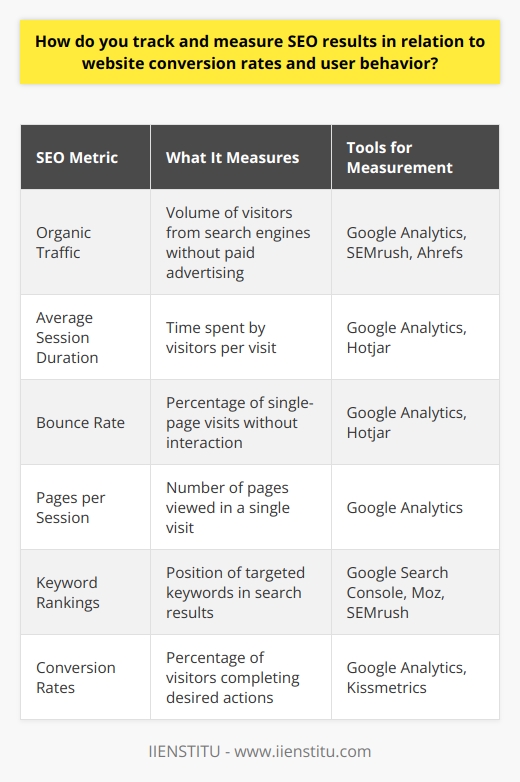
What metrics should I track for SEO to evaluate the effectiveness of content optimization strategies?
Key Metrics to Consider
To evaluate the effectiveness of content optimization strategies for search engine optimization (SEO), several key metrics should be tracked. These measures provide insights into how well your blog post is performing, and reveal areas for improvement.
Organic Traffic
Firstly, organic traffic refers to the number of users who find your blog post through search engine results, without paid promotions. This metric demonstrates the success of your SEO efforts, as higher organic traffic indicates better search engine visibility.
Bounce Rate
Bounce rate measures the percentage of visitors who leave your website after viewing only one page, signaling that the content did not meet their expectations. A high bounce rate suggests that improvements can be made, either in content quality, relevance, or user experience.
Time on Page
Monitoring the average time visitors spend on your blog post illustrates user engagement. A higher time on page indicates that the content is captivating and relevant to your target audience, while a lower time indicates the need for optimization.
Click-Through Rate (CTR)
CTR measures the percentage of people who click on your blog post's link in search engine results pages (SERPs) compared to the total number of impressions. A higher CTR signifies that the title and meta description are appealing and effective in attracting users to click on your post.
Keyword Rankings
Tracking the positions of targeted keywords in SERPs is crucial for understanding the effectiveness of your keyword optimization strategies. High-ranking keywords result in better visibility and increased organic traffic.
Backlinks
Backlinks are incoming links to your blog post from other websites, which contribute to your domain's authority and search engine rankings. Acquiring high-quality backlinks is a sign of successful content optimization.
User Metrics
User metrics, such as new and returning visitors, pages per session, and average session duration, provide overall insights into the performance of the blog post. Better user metrics indicate that the content is effectively engaging the audience, which helps improve search engine rankings.
In conclusion, tracking these essential metrics for SEO enables a comprehensive evaluation of the effectiveness of content optimization strategies. Regular monitoring and analysis of these measures will help identify areas for improvement and ensure the success of your blog post in search engine rankings.
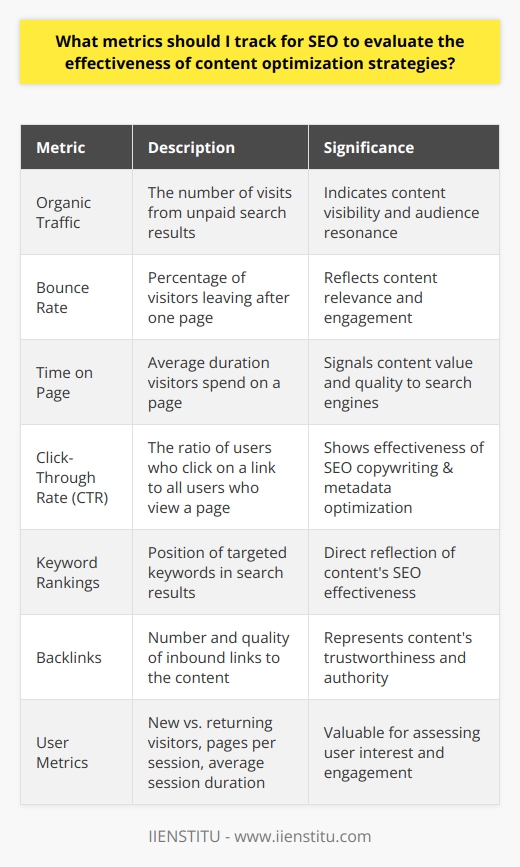
What are the important KPIs to consider for SEO when assessing the impact of technical improvements on website performance?
Key Performance Indicators for SEO Assessment
Organic Search Traffic
One crucial KPI to consider when assessing the impact of technical improvements on website performance is the organic search traffic. This metric quantifies the number of users who visit the website through search engines, providing valuable information about the effectiveness of SEO strategies.
Click-through Rate
Another important KPI is the click-through rate (CTR), which measures the percentage of users who click on a website's link after seeing it in search engine results. An increase in CTR may indicate that technical improvements like meta title and description optimizations are effective in enticing users to visit the website.
Bounce Rate
The bounce rate represents the percentage of users who leave the website after viewing only one page. Reducing bounce rate is vital for website performance, as it may be an indicator of technical issues, such as slow page loading times, navigational difficulties, or unresponsive design, ultimately affecting the user experience.
Pages per Session
Assessing the average number of pages that users view during a session can provide critical insights into user engagement levels. A higher pages per session value often indicates that users find the content and overall site structure more appealing—suggesting that technical improvements contribute to a better-performing website.
Average Session Duration
Understanding the average time users spend on the website during each session can help assess the impact of technical improvements on user engagement. A longer average session duration generally signifies greater user interest in the website's content and indicates that the technical improvements implemented have positively affected website performance.
Conversion Rate
Lastly, the conversion rate is a crucial KPI as it measures the percentage of website visitors who complete a desired action, such as purchasing a product or subscribing to a newsletter. This metric can help determine whether technical improvements have contributed to better user experience, facilitating users to complete targeted actions on the website.
In conclusion, when evaluating website performance and the impact of technical improvements, several key performance indicators must be considered, including organic search traffic, click-through rate, bounce rate, pages per session, average session duration, and conversion rate. By analyzing these KPIs, one can effectively assess the success of their SEO strategies and the overall performance of a website.
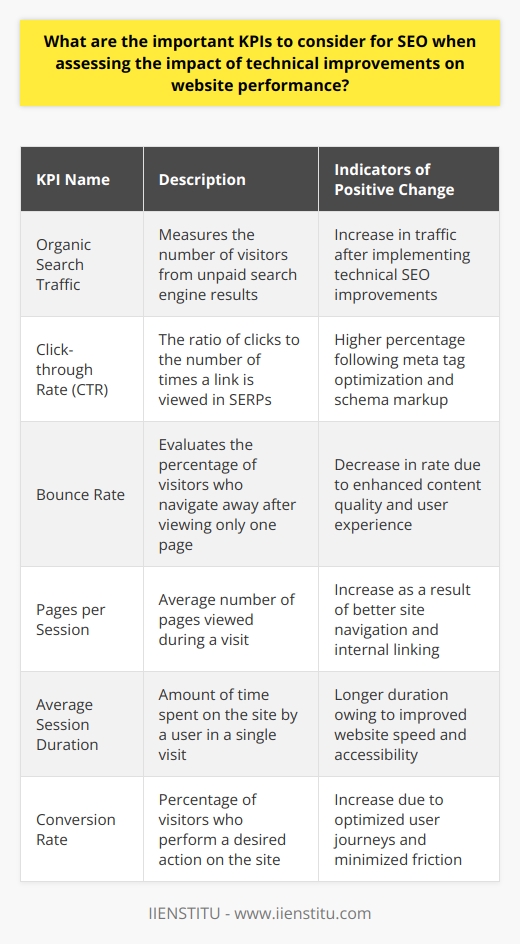
How do you measure SEO performance and results in terms of website authority and backlink profile?
Measuring SEO Performance for Website Authority
To evaluate the performance and results of search engine optimization (SEO) in terms of website authority, one must examine different metrics related to the overall site's presence in search engine rankings. Website authority is an indicator of how reputable and influential a website is, used by search engines to determine the value and credibility of its content. One reliable tool digital marketers and SEO professionals commonly use to measure website authority is the Domain Authority (DA) score developed by Moz, which calculates the total authority based on various data points including the quality and quantity of inbound links.
Assessing Backlink Profile Quality
Alongside website authority, it is crucial to consider the backlink profile when measuring SEO performance. A robust and healthy backlink profile comprises high-quality and relevant inbound links coming from authoritative domains pointing to a website. To assess this, one can use backlink analysis tools such as Ahrefs, Moz's Link Explorer, or Google's Search Console. These tools provide valuable insights into the number of referring domains, the strength and relevance of each link, and the overall health of a website's backlink profile.
Utilizing Metrics for Comprehensive Analysis
When analyzing the website authority and backlink profile, several significant metrics require attention, including:
Referring Domains: The number of unique domains linking to the site represents its ability to attract diverse sources, which influences the site's overall authority.
Domain Rating (DR) or Domain Authority (DA): These scores, provided by Ahrefs and Moz respectively, showcase the overall reputation and influence of a website within the search engine environment.
Trust Flow and Citation Flow: Developed by Majestic, these metrics measure the trustworthiness and influence of a site's backlinks, respectively.
Anchor Text Distribution: Analyzing the distribution of anchor texts in the backlinks can reveal any over-optimization or excessive use of exact-match keywords, which may suggest manipulative linking practices.
Link Velocity: The pace at which a website acquires new backlinks should be consistent and organic, as fluctuations might indicate unnatural link building activities.
By considering these metrics in conjunction, a comprehensive understanding of a website's SEO performance regarding authority and backlink profile can be attained. Consistently monitoring and analyzing this data enables informed decisions in SEO strategy and necessary adjustments to foster a stronger online presence and higher search engine rankings.
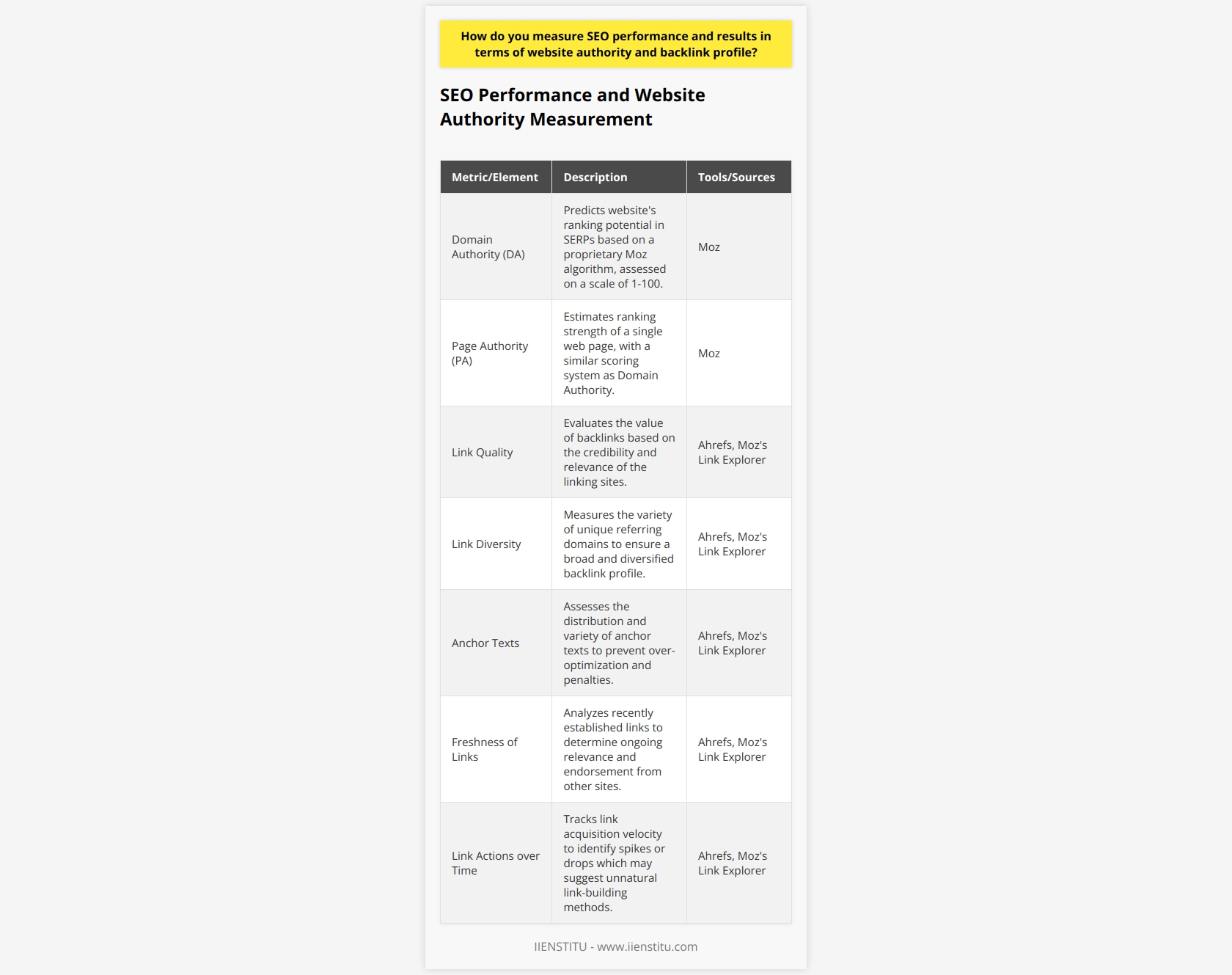
What are the key indicators used to track SEO progress with regards to user experience and site usability?
Assessing User Engagement Metrics
A crucial aspect of measuring SEO progress in relation to user experience and site usability lies within user engagement metrics. Specifically, these consist of time spent on site, pages per session, and bounce rate. A longer time spent on site demonstrates that visitors find the content valuable and engaging, thus reflecting enhanced user experience. Additionally, the number of pages viewed per session signifies an effective internal linking strategy, leading users seamlessly through the website.
Analyzing Click-through Rates
Another significant indicator is the click-through rate (CTR), which shows the ratio of clicks to page impressions. A high CTR suggests a successful combination of metadata, including compelling page titles and appealing meta descriptions that encourage users to explore further. This directly translates to an optimal user experience, as the right information at the right time meets their needs and enhances the site's usability.
Measuring Conversion Rates
Furthermore, examining conversion rate metrics allows for evaluation of the effectiveness of calls-to-action (CTAs) within the website. Ultimately, well-placed and persuasive CTAs prompt users to complete desired actions, whether signing up for newsletters, contacting customer support, or making a purchase. Monitoring conversion rates and carrying out A/B testing helps optimize these elements and contributes to an enjoyable, streamlined user experience.
Exploring Mobile Performance Metrics
The prevalence of mobile internet usage necessitates paying attention to mobile performance metrics, including mobile load times and mobile navigation. Speedy mobile load times guarantee a smooth browsing experience, while effective mobile navigation ensures ease of use for visitors. By tracking and optimizing these essential elements, website owners can create user-centric designs that cater to both desktop and mobile visitors, ensuring overall website accessibility and positive user experience.
Monitoring User Feedback
Finally, incorporating user feedback into SEO strategy is indispensable. Through qualitative data collection methods, such as surveys or reviews, valuable insights into users' preferences, needs, and pain points emerge. Understanding these dynamics helps prioritize improvements needed for the site's usability, thus enhancing user experience and ensuring positive long-term SEO outcomes.

Which reporting methods are most effective in measuring SEO success in relation to content engagement and social sharing?
Analyzing Reporting Methods for SEO Success
Content Engagement Metrics
Several reporting methods are highly effective in measuring SEO success concerning content engagement and social sharing for a blog post. Three crucial content engagement metrics include time on page, bounce rate, and pages per session. Time on page is important because it shows how long the reader stays engaged with the content, longer times indicating better engagement. Bounce rate measures the percentage of visitors who leave the site after viewing only one page, implying a lack of interest or engagement. Lastly, the pages per session metric indicates the average number of pages a user views in a single website visit. Higher pages per session represent better content engagement. These metrics are readily available in Google Analytics.
Social Sharing Indicators
In addition to content engagement, social sharing is a key factor in determining the effectiveness of SEO efforts, as it can indicate a high level of user interest and satisfaction with the content. A high rate of social sharing can lead to increased organic traffic, improved search engine rankings, and amplified brand awareness. The main reporting metrics to monitor social sharing are total shares, unique shares, and most shared content. These metrics can be collected using various social media analytical tools, such as BuzzSumo and Hootsuite.
Audience Engagement Analysis
To ensure a more holistic understanding of SEO success, analyzing audience engagement is crucial. Metrics, such as new vs. returning visitors, demographic information, and traffic sources, offer invaluable insights into user behavior and preferences. By examining these metrics, content creators and marketers can better tailor their strategies to target audience segments and improve content engagement outcomes. Tools, such as Google Analytics, provide these insights in a comprehensive manner.
Conclusion
In conclusion, the most effective reporting methods for measuring SEO success concerning content engagement and social sharing include monitoring content engagement metrics, social sharing indicators, and audience engagement analysis. Google Analytics is a valuable tool for evaluating content engagement, while social media analytical tools like BuzzSumo and Hootsuite can provide insights on social sharing performance. By consistently measuring and analyzing these metrics, content creators and marketers can optimize their strategies, leading to higher engagement and improved SEO results.



